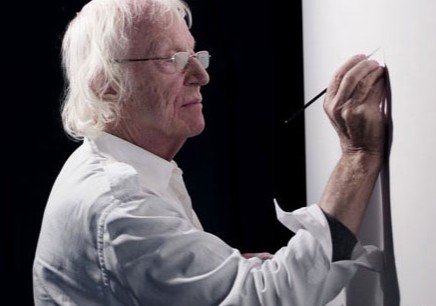(单词翻译:单击)
Roman Opalka
罗曼·欧帕尔卡
Roman Opalka, painter of infinity, died on August 6th, aged 79
罗曼·欧帕尔卡,绘制无限的画家,于八月六日逝世,享年79岁
SLOWLY, though his heart was pounding like a runner’s, Roman Opalka approached the canvas. He had painted it completely black. The date, though he set no store by dates, was 1965. Clenched in his left hand was a pot of white acrylic paint; held tightly in his right was a No. 0 brush, the smallest standard size. He dipped the fine tip into the paint and then, very gently, as if in slow motion, raised his arm. His hand was trembling. Carefully he painted the figure 1 at the top left-hand corner of the canvas. At the same time he whispered, in his native Polish, jeden, one. The moment was so charged with emotion that he thought he might collapse. Instead, he had begun.
尽管心跳已如奔跑的人一样快,罗曼·欧帕尔卡还是慢慢地走到画布前。画布已经被他全部涂上了纯黑色。这一天,尽管他没有记录日期,是在1965年。他左手端着一碟白色丙烯酸颜料,右手握住0号笔刷(标准号码里面最小的笔刷),然后笔尖蘸上颜料,轻柔地,慢慢地,抬起手臂。手在轻轻颤抖,他小心地在画布左上角写上“1”,用波兰话轻轻说道,jeden,一。这一刻,充满无限的感情,他感到自己要塌下了,只是,事实上,这正是他的起点。

He had thought about this for years, wondering how he might visualise time. He did not mean the time of clocks or calendars or hour-glasses; those were merely instruments of convenience for fixing points at which to have coffee, or feed the cat. That was time you could even reverse, by winding back the clock or tipping the hourglass over. He meant the irreversible continuum of time that flowed through him, the pulse of his life approaching his death within the vastness of infinity. For some years early in the 1960s he had played around with dabs and zigzags of monochrome paint on canvases which he called “Chronomes”, but he concluded that time was more orderly than that. By painting numbers in careful succession from one to infinity, or as near to it as he was destined to get, he would make a work of art that tracked as well as anything the movement of time in a life, and life in time.
关于怎样才能表达出时间的印象,他已经深思熟很多年。他想要的表达,不是时钟、日历、时漏这些仪器,这些仪器的用处是提醒人们什么时候去喝咖啡,什么时间去喂小猫咪,这样子的时间甚至都可以往回拨,钟表的指针可以回调,时漏可以颠倒。他想要表达出来的,是穿过他自己的时间,那是不可逆转的连续的时间,是在无限的广漠之中他生命的脉搏走向了死亡。在二十世纪六十年代早期几年里,他曾试着在用一种颜色在画布上点点,或是画之字,这种画他称之为“染色体”,但是最后他得出了这样的结论,即时间比它们都有序。所以他才想到用这样的方法来画画,在画布上写下数字,从一到无限,至少,到他有生之年能够到达的那个数字,这样,他能创作出的艺术品,才是对时间在生命之中的运动,或对生命在时间中的运动所做的纪录。
The idea came easily enough, while he was waiting one winter day in a cold café in Warsaw for his wife and his friends to come, glancing impatiently at clock and watch, drumming the moments away on the table. But it demanded nothing less than the sacrifice of his life. From the moment of painting the figure 1 until the day he died, when he had reached well past 5500000 (no commas marred his work), his daily task was painting numbers and whispering their names, eventually into a tape recorder. Hence his extreme emotion when he began: his own “big bang”, signalling his own creation of space-time.
他是在寒冬的一天在华沙一家咖啡厅里等他老婆和朋友的时候萌生了这样的想法,当时他不耐烦地看着钟表,一下下敲着桌子要把时间敲走。可是完成这样的想法也要他奉献一生的时间,从他写下1开始,直到他逝世的那天,他已经写到5500000了,他的作品没有一个分隔的逗号,他每天的任务就是写下数字,说那个数字,记录在录音带里。因此,开始的那一刻,他强烈的情绪,正是他的“宇宙大爆炸”,是他自己的创世纪。
Each canvas was called a “detail”, and all had the same title, “Opalka 1965/ 1-∞”. Typically he would paint around 400 figures a day, standing almost motionless at the easel. He tried not to travel much, did not take holidays, and if the journey was unavoidable made what he called cartes de voyage, continuing his numbers in black ink on ordinary white paper. The work became so absorbing, so meditative, that he would try to paint at the deepest hours of night, when only the bark of a dog or distant cock-crow would disturb the southern French hillside where he lived.
每一张画布都是一个“细节”,都有一样的标题“欧帕尔卡 1965/1-∞”。通常,他一天写大约400个数字,一动不动地站在画架前。他尽量少去旅行,也没有节假日,如果不得不出门旅行,他就写下“旅行卡片”,在普通的白纸上用黑墨水写下数字。他完全地沉浸在这份工作中,有时在深夜绘画,在他所住的位于法国南部的山边,只有能听到远处传来的狗叫或鸡鸣,
Heart trouble bothered him, and he once found the little paint-pot almost too heavy to lift, but he never considered stopping. The number 7777777 floated in his mind as a sort of completion of his “programme”; but in fact the completion would be his death, as he often said. Some critics saw his project as a sort of suicide, and he did not altogether dispute that. No sort of afterlife tempted him, he had no belief in one; but he very much liked a story by Marguerite Yourcenar in which a man built a boat and set out into infinity.
后来心脏有些问题让他有点吃力,有一阵感到那个小颜料碟都太重了拿不动,但是他还是不放弃。曾经他也想过7777777这个数字就是这项任务的终点了,但是他也经常说过,事实上终点只能是到他死的时候。有些评论家认为他这个任务就等于是自杀,他没有辩驳。他也没有想过身后名声之类的,也不相信谁。不过,他倒是很喜欢玛格丽特·尤瑟纳尔讲的一个故事,讲有一个男人,造了一艘船,就这样开到无边无际的地方去了。
Over the 46 years of his enterprise, his technique and materials barely changed. His canvases, 233 in all, were always 196 x 135cm, a good size to work at standing and to carry in outstretched arms. Brush and paint never varied. His figures were roughly a centimetre tall,
most made with two deliberate strokes of the brush, and allowed to fade away as his paint ran out, like the trailing tail of a comet. He often said he painted like a man out walking, unaware of his steps unless he stumbled. If that happened, he never went back.
在他这项为期46年的事业里,他使用的材料,绘画的技巧一点都没变。总共233幅画布,都是196 x 135cm,大小刚好适合站着画,而且双手展开拿着看也合适。绘画的刷子和颜料还和最初用的一样,数字大约一厘米高,其笔法大多数都是笔刷小心地刷过两遍,再轻轻地淡出,像彗星的尾巴。他常说自己的画法,就像出去散步的人,除非遇到嗑嗑绊绊,否则没有意识到自己的脚步。也许他也遇到过嗑绊,但是他不曾回头。
His biggest innovation was to change the background colour. In 1968 he made it grey; in 1972—when, barely able to breathe, he passed 1000000—he decided to add 1% more white to that grey every year. By 2008 the white of ground and figures was virtually the same, except that he thought of the ground as “well-earned white”, arduously brought out of the original black, and except that the newly painted figures would shine out against it until they dried. He approached this invisibility with a sort of exaltation.
他最大的创新在于更改画布的背景颜色。1968年开始使用灰色的背景,1972年他的身体已经非常虚弱,他已经写下了1000000,决定每过一年,就在那种灰色颜料里加1%的白色颜料。到2008年,背景色就是白色的,和写数字的颜料几乎无差,他认为,背景的白色是时光沉淀下来的白,是从最初的黑色当中一点点绽放出来的白色,与最初的白色不一样。新画上去的数字,颜料在颜料干了之后可以看出来。他认为就是这点难以发现的特点让他感到欣喜。”
Self-portrait with numbers
与数字一起的自拍像
From 1968, at the end of every working day, he took a black-and-white photograph of his impassive face against the canvas. This too was part of the project. It was not egoism or narcissism, he insisted. After all, his art told people nothing about his quotidian life. None of it—the birth in France, the childhood in Poland interrupted by war, the art studies in Warsaw, the year in Berlin—seemed important beside the immensity of the self-imposed task. He spoke about that, when asked, rather diffidently, softly rubbing the rims of his glasses in one hand, talking of Heidegger and Pascal and the notions of number held by the ancient Greeks, smiling often with what seemed to be repressed joy. And why not? Though people saw him as a prisoner, he felt more liberated with every stroke of the brush. Each of his self-portraits, with steadily silvering hair and whitening skin, showed him progressing as inevitably as his numbers into the infinity he longed for.
从1968年起,每天工作结束,他都站在画布前照一张黑白照,都是些像寸照一样的照片,照他没有表情的脸。这也是这个项目的一部分。他说,这不是自我中心,更不是自恋。毕竟,他的作品里没有传达任何关于他平日生活的事情,一点都没有,没有关于他在法国出生的事情,没有他在波兰经历战争的童年生活,没有他在华沙学习艺术的事情,没在柏林那一年的事情,这些,与他自愿接受的这项巨大任务相对都不重要。人们问到他的作品时,他有点羞怯,轻轻扶了下眼镜框,谈起海格德尔,帕斯卡,谈成古代希腊人赋予数字的意义,他笑起来,带着点压抑的欢乐。怎能不欢乐?人们看他像住在监狱里,可是每刷动一次笔刷,他都感觉到更加自由。他每一幅自拍照片,银色的头发,白的肤色,展示着他的生命就像他所渴望的无穷的数字一样不可逆转地延续着。


